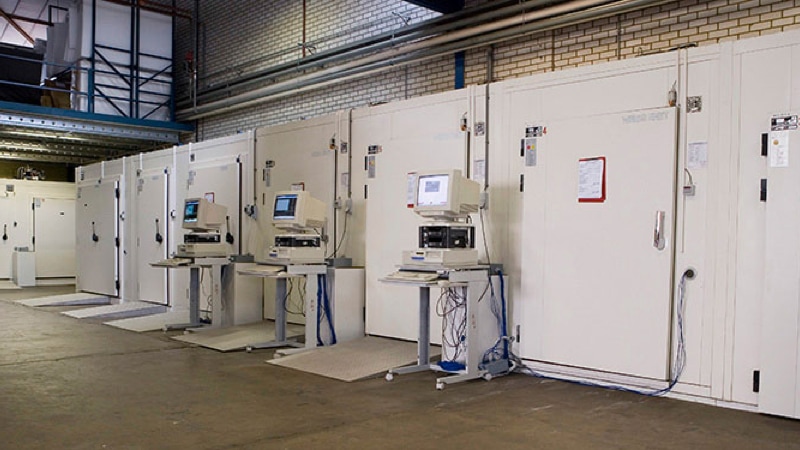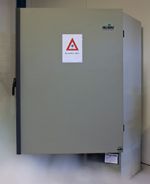Climate-/temperature chambers

Products and their packaging have to deal with weather and temperature fluctuations during transport. Moisture, cold and heat all affect the packaging and/or product.
Products, such as medicines should absolutely experience no problems here. But also the packaging may be weakened resulting in unstable pallet loads.
In many cases the packaging is also subjected to a transport simulation test in addition to a thermal test.
Various tests
Temperature test for the pharmaceutical industry
In order to test whether a thermal packaging actually meets the required temperature criteria, a temperature test is performed. Thermocouples are applied in the product or against the primary packaging. The product, insulated container, refrigerants and the remaining components are (usually) preconditioned for 24 hours to prepare for the test. The product is packed and placed in the temperature chamber that simulates the outside temperature. Several thermocouples are placed on the outside of the packaging to register the ambient temperature. The thermocouples are connected to a data logger that registers the temperature at a predetermined interval. After the test, the data can be processed into a graph that shows the temperature curve of the thermal packaging.Climate test
Prior to a transport simulation test, a climate test is often performed. By bringing the packaging or pallet load to the expected temperature and humidity, it can be simulated and investigated how a packaging or pallet load responds to high humidity conditions or how extremely low temperatures affect the packaging materials.
Long duration test/accelerated aging test
Long duration temperature or climate tests are conducted to simulate the influence of humidity and/or temperature on the product and packaging. This can be done with multiple pallets or with only a few pieces per test, depending on the client’s wishes. Points for attention during long duration temperature or climate tests are the effect of temperature and humidity on the shelf life of the product (accelerated aging test), determining permeability of the packaging, or simulating long-term (sea) transport.Ultra-low freezers
 |
The ultra-low freezers are employed during the conditioning and testing of products that need to be transported at extremely low temperatures (to -80 °C). These are usually pharmaceutical products that must remain frozen and are kept at the right temperature during transport by means of dry ice. The chambers can also be used during temperature shock tests where the product is placed from the ultra-low freezer into a warm chamber to examine whether this has a negative effect on the product. For example, the materials of the product can get damaged due to shrinking or swelling. |
International standards
Climate tests exist in many shapes and sizes and can be conducted in accordance with international standards and client-specific profiles. Possible international standards are:- All ISTA standards
- ASTM D3103
- ASTM D4169
- ASTM D4332
- ASTM F1980
- ISO 2233
- ISO 4180
16 climate chambers and 4 ultra-low freezers
Manufacturer climate chambers: Weiss Enet- The sizes of the various chambers differ per chamber. On average, these chambers offer room for 2 pallets plus a load up to a height of 2 meters. Topa Institute also has larger rooms, where up to 6 pallets can be tested simultaneously. The format of the doors vary from 90 x 200 cm to 240 x 200 cm.
- All chambers have a temperature range within which testing can take place. This varies from -35 °C to +70 °C (+/- 2 °C).
- Moreover, four chambers offer the possibility to – in addition to temperature – also test the relative humidity ranging from 15% to 95%.
- In all chambers, a temperature profile, possibly with humidity, can be programmed.
- All climate chambers and measuring equipment are calibrated annually.
- Size (width x depth x height): 86 x 60 x 128 cm
- Door opening: 86 x 128 cm
- Temperature range: -85 °C to -40 °C (+/- 2 °C)
- Temperature settings: only a constant temperature setting is possible
- Calibration interval: annual

